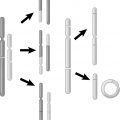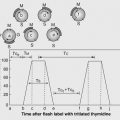27
STEM CELLS
HAIDONG HUANG AND JENNIFER S. YU
Question 1
What are stem cells and what are their roles in the body?
Question 3
What are embryonic stem (ES) cells?
Question 1 What are stem cells and what are their roles in the body?
Answer 1
Stem cells are specific cells in the body that have the potential to develop into many different cell types. Stem cells have two major important characteristics: self-renewal and differentiation. As stem cells divide, the daughter cells can either retain stem cell features or differentiate. Under certain physiological or experimental conditions, stem cells can differentiate into tissue- or organ-specific cells with special functions. Stem cells in the body produce cells to support tissue formation and function and replace aging or dead cells. Stem cells can also be stimulated after tissue injury to produce differentiated cells to repair or replace the damaged tissue.
Goodell MA, Nguyen H, Shroyer N. Somatic stem cell heterogeneity: diversity in the blood, skin and intestinal stem cell compartments. Nat Rev Mol Cell Biol. 2015;16:299–309.
Martello G, Smith A. The nature of embryonic stem cells. Annu Rev Cell Dev Biol. 2014;30:647–675.
Question 3 What are embryonic stem (ES) cells?
Answer 3
ES cells are obtained from the inner cell mass in the mid-blastocyst stage (in the mouse, it is embryonic day 3.5 and in the human, it is 3 to 5 days after an egg cell is fertilized by a sperm). In normal development, the cells inside the inner cell mass are pluripotent and will produce all kinds of differentiated cells of tissues and organs in the entire body. These cells can be extracted and grown in vitro under specific conditions to retain the properties of ES cells.
Goodell MA, Nguyen H, Shroyer N. Somatic stem cell heterogeneity: diversity in the blood, skin and intestinal stem cell compartments. Nat Rev Mol Cell Biol. 2015;16:299–309.
Martello G, Smith A. The nature of embryonic stem cells. Annu Rev Cell Dev Biol. 2014;30:647–675.
Question 5
What are adult stem cells?
Question 7
What are the main approaches for researchers to obtain adult stem cells?
Question 5 What are adult stem cells?
Answer 5
Adult stem cells are undifferentiated cells in adult animals that can self-renew and also give rise to differentiated cells. Adult stem cells have been identified in the brain, blood vessels, muscle, skin, teeth, and liver and therefore have their own names corresponding to their tissue origins (e.g., neural stem cells, muscle stem cells). Adult stem cells are thought to live in a specific niche in each tissue, where they either divide continuously to produce new cells to replace dead cells, or remain dormant for years, dividing and creating new cells as needed.
Goodell MA, Nguyen H, Shroyer N. Somatic stem cell heterogeneity: diversity in the blood, skin and intestinal stem cell compartments. Nat Rev Mol Cell Biol. 2015;16:299–309.
Martello G, Smith A. The nature of embryonic stem cells. Annu Rev Cell Dev Biol. 2014;30:647–675.
Question 7 What are the main approaches for researchers to obtain adult stem cells?
Answer 7
Adult stem cells exist in special locations of many tissues and organs and can be obtained by many different methods. (a) Some stem cells can be isolated from the body directly. For example, blood stem cells can be taken from a donor’s bone marrow, from blood in the umbilical cord, or from a person’s circulating blood. Neural stem cells have been isolated from the brain and spinal cord. (b) Amniotic fluid contains a mixture of stem cells that have the ability to develop into skin, cartilage, cardiac tissue, nerves, muscle, and bone. (c) Some types of adult stem cells can be produced through inducing embryonic stem (ES) cells with particular chemical and mechanical factors. (d) Other adult stem cells can transform or differentiate into apparently unrelated cell types (e.g., brain stem cells that differentiate into blood cells). Although this transdifferentiation has been reported in animals, its mechanism is not clear and its application is very limited.
Cananzi M, Atala A, De Coppi P. Stem cells derived from amniotic fluid: new potentials in regenerative medicine. Reprod Biomed Online. 2009;18:17–27.
Question 8
What is asymmetric division of stem cells?
Stay updated, free articles. Join our Telegram channel

Full access? Get Clinical Tree






